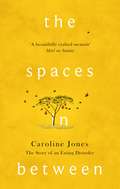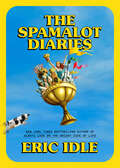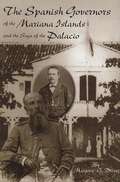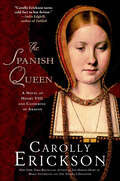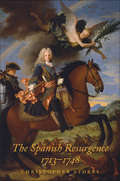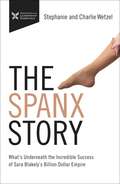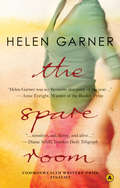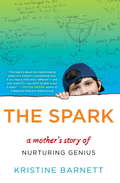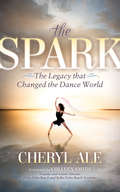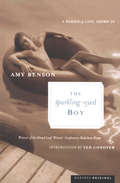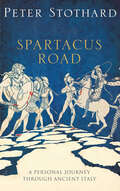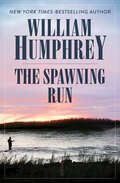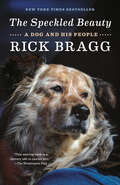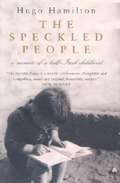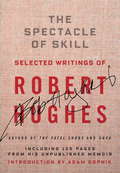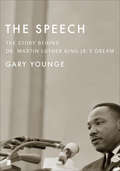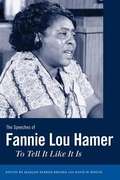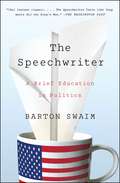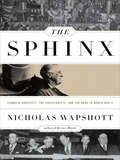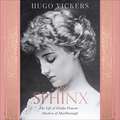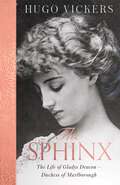- Table View
- List View
The Space Station: A Personal Journey
by Hans MarkThis insider's account, a penetrating view of science policy and politics during two presidencies, captures the euphoria that characterized the space program in the late seventies and early eighties and furnishes an invaluable perspective on the Challenger tragedy and the future of the United States in space.President Reagan's approval of $8 billion for the construction of a permanently manned orbiting space station climaxed one of the most important political and technological debates in the history of the U.S. program in space. In The Space Station the story of this debate is told by Hans mark, who had major roles in the development of the space shuttle from its beginnings in the sixties and who bore a primary responsibility for overseeing the space station project during the decisive years from 1981 to 1984.Mark's appointment to the post of deputy administrator of NASA capped a career devoted to the development and management of space technology--he served as director of NASA's Ames Research Center, then as under secretary and later secretary of the U.S. Air Force. Serving under both President Carter and President Reagan, mark is uniquely able to chronicle the intricate process by which the space shuttle became a reality and the space station an acknowledged goal of the American space effort.A scientist by training, Mark's account of his career in the space program is the story of a personal dream as well as the story of a vast public enterprise whose human side is only now being fully appreciated.
The Spaces In Between: The Story of an Eating Disorder
by Caroline Jones'Beautiful and heart-rending . . . I could smell Africa on every page' - A. A. GillCaroline Jones was born in Ethiopia and spent most of her childhood in East Africa. She read French and Spanish at Oxford University and went on to make documentaries for the BBC. Now aged 39, she is happily married with two children. Yet beneath this seemingly perfect public exterior, Caroline was in fact privately indulging in a pattern of destructive behaviour that left her exhausted, anxious, depressed and full of self-loathing - from the ages of 17 to 31, for 14 years, Caroline was suffering from an extremely widespread yet comparatively little-talked about mental illness - bulimia. Caroline is articulate, intelligent, insightful and frank about her experiences, interweaving the journey of her illness with memories of her African childhood, her time at Oxford, her work for the BBC, her family and other relationships, making for a warm and engaging memoir. Her perceptive, retrospective approach to her illness allows her to transcend the topic of bulimia and talk more generally about self-destructive behaviour - there are lessons here which will speak to a little part of everyone.
The Spamalot Diaries
by Eric Idle&“A rollicking account of the making of [the] Broadway musical Spamalot [and] an irresistible and unfiltered ode to the art of live theater. Fans will love this tantalizing glimpse behind the curtain.&”—Publishers Weekly (starred review)From comedy legend Eric Idle, the fascinating inside story of bringing Monty Python and the Holy Grail to Broadway as the unlikely theatrical hit Spamalot On March 17, 2005, Spamalot debuted on Broadway to rapturous reviews for its star-studded creative team, including creators Eric Idle and John du Prez, director Mike Nichols, and stars Hank Azaria, David Hyde Pierce, Sara Ramirez, Tim Curry, and more. But long before the show was the toast of Broadway and the winner of three Tony Awards, it was an idea threatening to fizzle out before it could find its way into existence. Now, in The Spamalot Diaries, Eric Idle shares original journal entries and raw email exchanges—all featuring his whip-smart wit—that reveal the sometimes bumpy, always entertaining path to the show&’s unforgettable run. In the months leading up to that opening night, financial anxieties were high with a low-ceiling budget and expectations that it would take two years to break even. Collaborative disputes put decades-long friendships to the test. And the endless process of rewriting was a task as passionate as it was painstaking. Still, there&’s nothing Idle would change about that year. Except for the broken ankle. He could do without the broken ankle. Chronicling every minor mishap and triumph along the way, as well as the creative tension that drove the show to new heights, The Spamalot Diaries is an unforgettable look behind the curtain of a beloved musical and inside the wickedly entertaining mind of one of our most treasured comic performers.
The Spanish Governors Of The Mariana Islands And The Saga Of The Palacio
by Marjorie G. DriverMore than fifty Spanish officers served as governors during the 230 years that Spain administered the Mariana Islands, from 1668 to 1898. A dozen or so received six-year royal appointments, made in Madrid by the king, though the vast majority served three-year interim appointments, made in Manila by the Governor General or the Audiencia. In the nineteenth century, as the newly designated Province of the Mariana Islands, appointments to the governorship were often made by the Captaincy General of the Philippines. The source materials for this work are found primarily among the holdings of the Micronesian Area Research Center, Spanish Documents Collection, a secondary repository with copies of documentary materials concerning Micronesia from institutional collections in various parts of the world, though primarily Spain, Mexico, and the Philippines.
The Spanish Queen: A Novel of Henry VIII and Catherine of Aragon
by Carolly EricksonA powerful novel about Henry VIII’s first wife, the mother of Mary I, by the New York Times–bestselling author of The Last Wife of Henry VIII.When young Catherine of Aragon, proud daughter of King Ferdinand and Queen Isabella, is sent to England to marry the weak Prince Arthur, she is unprepared for all that awaits her: early widowhood, the challenge of warfare with the invading Scots, and the ultimately futile attempt to provide the realm with a prince to secure the succession. She marries Arthur’s energetic, athletic brother Henry, only to encounter fresh obstacles, chief among them Henry’s infatuation with the alluring but wayward Anne Boleyn.In The Spanish Queen, bestselling novelist Carolly Erickson allows the strong-willed, redoubtable Queen Catherine to tell her own story—a tale that carries her from the scented gardens of Grenada to the craggy mountains of Wales to the conflict-ridden Tudor court. Surrounded by strong partisans among the English, and with the might of Spanish and imperial arms to defend her, Catherine soldiers on, until her union with King Henry is severed and she finds herself discarded—and tempted to take the most daring step of her life.Carolly Erickson’s historical entertainments continue to succeed in creating a unique blend of historical authenticity and page-turning drama.Praise for The Spanish Queen“Although even Erickson’s fact-bending “historical entertainment” cannot alter the grim outcome, Catherine’s ordeal is so sensitively recreated that readers will still hope for a different ending. A vivid evocation of a queen who refused to be written off.” —Kirkus Reviews“Erickson explores the range of Catherine’s emotions over the death of her first husband, the loss of several children and the betrayal of King Henry. Her Catherine brims with emotions, at one turn kind and understanding, at another seething with hurt and jealousy. This multifaceted characterization of Catherine is much more satisfying than previous portrayals. Highly recommended.” —Historical Novel Society“The writing is beautiful, the characters are marvelous, and the story masterfully crafted. I will certainly read Erickson’s next historic fiction.” —San Francisco Book Review
The Spanish Resurgence, 1713-1748
by Christopher StorrsA major reassessment of Philip V's leadership and what it meant for the modern Spanish state Often dismissed as ineffective, indolent, and dominated by his second wife, Philip V of Spain (1700-1746), the first Bourbon king, was in fact the greatest threat to peace in Europe during his reign. Under his rule, Spain was a dynamic force and expansionist power, especially in the Mediterranean world. Campaigns in Italy and North Africa revitalized Spanish control in the Mediterranean region, and the arrival of the Bourbon dynasty signaled a sharp break from Habsburg attitudes and practices. Challenging long-held understandings of early eighteenth-century Europe and the Atlantic world, Christopher Storrs draws on a rich array of primary documents to trace the political, military, and financial innovations that laid the framework for the modern Spanish state and the coalescence of a national identity. Storrs illuminates the remarkable revival of Spanish power after 1713 and sheds new light on the often underrated king who made Spain's resurgence possible.
The Spanx Story: What's Underneath the Incredible success of Sara Blakely's Billion Dollar Empire (The Business Storybook Series)
by Charlie Wetzel Stephanie WetzelWhat can you learn from one of the most successful companies in the world? The Spanx Story will help you understand and adopt the competitive strategies, workplace culture, and daily business practices that enabled entrepreneur Sara Blakely to dominate the shapewear industry and become a billionaire.Sara Blakely had a problem. She had a beautiful pair of white designer pants hanging in her closet just calling out to her to wear them, even though they accented her least favorite feature: cellulite. After searching high and low for a solution and coming up empty, an idea was born: Spanx.The Spanx Story chronicles Sara&’s journey from long nights researching patent and trademark law, to years of cold shoulders she received from the titans of the pantyhose industry, to the cold call that led to the shelves of Nieman Marcus. It was a long road of incredible hard work and determination that led Spanx to become the iconic brand it is today.Through Sara&’s story, you will learn:How to develop an idea and turn it into a business.How to start a company with very little capital by thinking outside of the box and dedicating every spare moment to your goal.How to recognize when it&’s better to hire a CEO than to be the CEO.How to stay the course and continue to believe in your idea, despite naysayers and going against an industry resistant to innovation.The Spanx Story educates and inspires entrepreneurs and innovators to find the problem for their solutions and persevere through the hard work that goes into building a billion-dollar company.
The Spare Room
by Helen GarnerWinner of several prestigious prizes, The Spare Room is extraordinary writer Helen Garner's intense, moving investigation of the boundaries and limits of a lifelong friendship.As the novel opens, Helen lovingly prepares the spare room in her home for her dear friend Nicola, who is coming to visit for three weeks while receiving controversial treatment for late-stage cancer. From the moment Nicola staggers off the plane, gaunt and hoarse but still somehow grand, Helen becomes her nurse, her guardian angel, and her stony judge. The Spare Room tells an unforgettable story full of complex humour, rage, and compassion.
The Spark: A Mother's Story of Nurturing, Genius, and Autism
by Kristine BarnettThe extraordinary memoir of a mother's love, commitment and nurturing, which allowed her son, originally diagnosed with severe autism, to flourish into a universally recognized genius--and how any parent can help their child find their spark. Today, at 13, Jacob is a paid researcher in quantum physics, working on extending Einstein's theory of relativity. Diagnosed at 1 with severe autism, at 3 he was assigned to life-skills classes and his parents were told to adjust their expectations. The goal: tying his own shoes at 16. Kristine's belief in the power of hope and the dazzling possibilities that can occur when we keep our minds open and learn to fuel a child's true potential changed everything.From the Hardcover edition.
The Spark: The Legacy that Changed the Dance World
by Cheryl AleThe Spark will help create a legacy dance students will never forget!The Spark: The Legacy that Changed the Dance World is about the journey of creative artists and dancers-turned-teachers who are now struggling with the complexities of teaching. Choosing a ballet program that juggles all styles, techniques, and methodologies and that all levels of students will progressively love is a daunting task. In this book, dance teachers will discover what the greatest masters have always known: the true essence of dancing. Quite simply, they will learn how to teach pure, fluid movement with an age-appropriate curriculum proven for the past 60 years to effectively transcend any limiting beliefs about the basis for all dance. If you’re looking for an empowered learning community with the perfect balance of discipline, integrity, and a curriculum that forms lifetime bonds with students, teachers, and parents, you’ve come to the right place. Celebrate your “sparkdom”!
The Sparkling-Eyed Boy: A Memoir of Love, Grown Up
by Amy Benson"The Sparkling-Eyed Boy is so full of color and light and life. " -- Brad Land, author of Goat The theme of summer love, in Amy Benson's hands, grows up: The Sparkling-Eyed Boy searches out the fault lines of adult nostalgia and desire. The achingly intense adolescent summer days that Amy Benson and the sparkling-eyed boy spend together on the remote shores of the St. Mary's River of Michigan's Upper Peninsula are at the complex emotional center of The Sparkling-Eyed Boy. For her, summers meant returning from her home in Detroit to a three-month idyll on much-loved family land, owned for generations, and to a heady culture of teasing, testing local boys. For him, this land is the place he was born, where he'll later find work, marry, and stay: and she was the one he had loved. "Can you pinpoint that moment? When you made a choice before you even knew that choosing was possible, or the terrifying nature of choices?" The Sparkling-Eyed Boy, with its heart-stoppingly erotic -- and yet wholly imagined -- scenes of illicit love, its searching riffs on love as possession, love as pain, reads like a friend's deepest secrets, shared. "The Sparkling-Eyed Boy is so full of color and light and life. This is truth of the most profound sort; truth revealed in the artful and lyrical sensibility of Benson’s words and memory. She is dancing with us: not leading, but simply asking us to watch her move and take what we will. Benson shows us here what the memoir can and should do - destroy and resurrect itself over and over. Benson is doing exactly that. ” - Brad Land, author of Goat "The great pleasure and triumph of this memoir is Amy Benson’s ability to make the familiar new again as she explores the country of first love. Over and over I found myself surprised by the unexpected twists and turns, peaks and abysses, of her journey. And also by her lovely, fiercely intelligent prose. ” - Margot Livesey, author of Criminals
The Spartacus Road: A Personal Journey Through Ancient Italy
by Peter StothardA classicist retraces the ancient journey taken by the Spartacus and his army of rebels through Italy in the first century BC Gladiator War.In the final century of the first Roman Republic, an army of slaves undertook a historic revolt. Led by the gladiator Spartacus, its success was something no one before had ever known. The Spartacus Road is the route along which this rebel army outfought the Roman legions between 73 and 71BC, bringing both fears and hopes that have never wholly left the modern mind. It is a road that stretches through 2,000 miles of Italian countryside and out into 2,000 years of world history.In this inspiring and original memoir, the former editor of The Times, Peter Stothard, takes us on an extraordinary journey. The result is a book like none other: at once a journalist’s notebook, a classicist’s celebration, a survivor’s record of a near fatal cancer and the history of a unique and brutal war. As he travels along the Spartacus road—through the ruins of Capua to Vesuvius and the lost Greek cities of the Italian south—Stothard illuminates conflicting memories of times ancient and modern, breathing new life into one of the greatest stories of the ages.
The Spawning Run
by William HumphreyWilliam Humphrey's delightful chronicle of an angling holiday in Wales celebrates two equally astonishing creatures: the Atlantic salmon and the British fly fisherman In order to mate in the same freshwater stream where it was spawned, the salmon swims one thousand miles or more and overcomes countless obstacles, from trawling nets to twelve-foot-high waterfalls. To catch the King of Fish at the end of its incredible journey, the Anglo-Saxon angler subjects his pride, his bank account, and his taste buds--poached milk, anyone?--to similar dangers. Nine out of ten salmon do not make it back to the sea once their spawning run is finished; nine out of ten sportsmen return to the hotel empty handed when the fishing day is done. And yet, year after year, they return to the rivers and streams of Great Britain--fish and angler both. Why? Perhaps "poor Holloway," who has yet to land a salmon after twenty spawning seasons but whose success rate with the bored wives of more skillful fisherman is scandalously impressive, knows the answer. An elegant blend of fishing narrative, travelogue, and character study, The Spawning Run is a hilarious and heartfelt tribute to the irresistible passions that unite us all: man, woman, and salmon. This ebook features an illustrated biography of William Humphrey including rare photos form the author's estate.
The Speckled Beauty: A Dog and His People
by Rick BraggFrom the best-selling, Pulitzer Prize-winning author of All Over but the Shoutin', the warm hearted and hilarious story of how his life was transformed by his love for a poorly behaved, half-blind stray dog. <P><P>Speck is not a good boy. He is a terrible boy, a defiant, self-destructive, often malodorous boy, a grave robber and screen door moocher who spends his days playing chicken with the Fed Ex man, picking fights with thousand-pound livestock, and rolling in donkey manure, and his nights howling at the moon. He has been that way since the moment he appeared on the ridgeline behind Rick Bragg's house, a starved and half-dead creature, seventy-six pounds of wet hair and poor decisions. <P><P>Speck arrived in Rick's life at a moment of looming uncertainty. A cancer diagnosis, chemo, kidney failure, and recurring pneumonia had left Rick lethargic and melancholy. Speck helped, and he is helping, still, when he is not peeing on the rose of Sharon. Written with Bragg's inimitable blend of tenderness and sorrow, humor and grit, The Speckled Beauty captures the extraordinary, sustaining devotion between two damaged creatures who need each other to heal. <P><P><b>A New York Times Best Seller</b>
The Speckled People
by Hugo Hamilton"The childhood world of Hugo Hamilton, born and brought up in Dublin, is a confused place. His father, a sometimes brutal Irish nationalist, demands his children speak Irish, while his mother, a softly spoken German emigrant who has been marked by the Nazi past, talks to them in German. He himself wants to speak English. English is, after all, what the other children in Dublin speak. English is what they use when they hunt him down in the streets and dub him Eichmann, as they bring him to trial and sentence him to death at a mock seaside court. Out of this fear and guilt and often comical cultural entanglements, he tries to understand the differences between Irish history and German history and turn the twisted logic of what he is told into truth. It is a journey that ends in liberation, but not before he uncovers the long-buried secrets that lie at the bottom of his parents' wardrobe."--BOOK JACKET.Title Summary field provided by Blackwell North America, Inc. All Rights Reserved
The Spectacle of Skill
by Adam Gopnik Robert Hughes"I am completely an elitist, in the cultural but emphatically not the social sense. I prefer the good to the bad, the articulate to the mumbling, the aesthetically developed to the merely primitive, and full to partial consciousness. I love the spectacle of skill, whether it's an expert gardener at work, or a good carpenter chopping dovetails . . . I don't think stupid or ill-read people are as good to be with as wise and fully literate ones. I would rather watch a great tennis player than a mediocre one . . . Consequently, most of the human race doesn't matter much to me, outside the normal and necessary frame of courtesy and the obligation to respect human rights. I see no reason to squirm around apologizing for this. I am, after all, a cultural critic, and my main job is to distinguish the good from the second-rate." Robert Hughes wrote with brutal honesty about art, architecture, culture, religion, and himself. He translated his passions--of which there were many, both positive and negative--brilliantly, convincingly, and with vitality and immediacy, always holding himself to the same rigorous standards of skill, authenticity, and significance that he did his subjects. There never was, and never will be again, a voice like this. In this volume, that voice rings clear through a gathering of some of his most unforgettable writings, culled from nine of his most widely read and important books. This selection shows his enormous range and gives us a uniquely cohesive view of both the critic and the man. Most revealing, and most thrilling for Hughes's legions of fans, are the never-before-published pages from his unfinished second volume of memoirs. These last writings show Robert Hughes at the height of his powers and can be read only with pleasure and a tinge of sadness that his extraordinary voice is no longer here to educate us as well as to clarify and define our world.From the Hardcover edition.
The Spectacle of Skill: New and Selected Writings of Robert Hughes
by Adam Gopnik Robert Hughes"I am completely an elitist, in the cultural but emphatically not the social sense. I prefer the good to the bad, the articulate to the mumbling, the aesthetically developed to the merely primitive, and full to partial consciousness. I love the spectacle of skill, whether it's an expert gardener at work, or a good carpenter chopping dovetails . . . I don't think stupid or ill-read people are as good to be with as wise and fully literate ones. I would rather watch a great tennis player than a mediocre one . . . Consequently, most of the human race doesn't matter much to me, outside the normal and necessary frame of courtesy and the obligation to respect human rights. I see no reason to squirm around apologizing for this. I am, after all, a cultural critic, and my main job is to distinguish the good from the second-rate." Robert Hughes wrote with brutal honesty about art, architecture, culture, religion, and himself. He translated his passions--of which there were many, both positive and negative--brilliantly, convincingly, and with vitality and immediacy, always holding himself to the same rigorous standards of skill, authenticity, and significance that he did his subjects. There never was, and never will be again, a voice like this. In this volume, that voice rings clear through a gathering of some of his most unforgettable writings, culled from nine of his most widely read and important books. This selection shows his enormous range and gives us a uniquely cohesive view of both the critic and the man. Most revealing, and most thrilling for Hughes's legions of fans, are the never-before-published pages from his unfinished second volume of memoirs. These last writings show Robert Hughes at the height of his powers and can be read only with pleasure and a tinge of sadness that his extraordinary voice is no longer here to educate us as well as to clarify and define our world.From the Hardcover edition.
The Speech: The Story Behind Dr. Martin Luther King Jr.'s Dream
by Gary YoungeIn this &“slim but powerful book,&” the award-winning journalist shares the dramatic story surrounding MLK&’s most famous speech and its importance today (Boston Globe).On August 28, 1963, Dr. Martin Luther King Jr. led the historic March on Washington for Jobs and Freedom, where he delivered the most iconic speech of the civil rights movement. In The Speech, Gary Younge explains why King&’s &“I Have a Dream&” speech maintains its powerful social relevance by sharing the dramatic story surrounding it. Today, that speech endures as a guiding light in the ongoing struggle for racial equality.Younge roots his work in personal interviews with Clarence Jones, a close friend of Martin Luther King Jr. and his draft speechwriter; with Joan Baez, a singer at the march; and with Angela Davis and other leading civil rights leaders. Younge skillfully captures the spirit of that historic day in Washington and offers a new generation of readers a critical modern analysis of why &“I Have a Dream&” remains America&’s favorite speech. &“Younge&’s meditative retrospection on [the speech&’s] significance reminds us of all the micro-moments of transformation behind the scenes—the thought and preparation, vision and revision—whose currency fed that magnificent lightning bolt in history.&” —Patricia J. Williams, legal scholar and theorist
The Speeches of Fannie Lou Hamer: To Tell It Like It Is
by Fannie Lou Hamer Maegan Parker Brooks Davis W. HouckMost people who have heard of Fannie Lou Hamer (1917-1977) are aware of the impassioned testimony that this Mississippi sharecropper and civil rights activist delivered at the 1964 Democratic National Convention. Far fewer people are familiar with the speeches Hamer delivered at the 1968 and 1972 conventions, to say nothing of addresses she gave closer to home, or with Malcolm X in Harlem, or even at the founding of the National Women's Political Caucus. Until now, dozens of Hamer's speeches have been buried in archival collections and in the basements of movement veterans. After years of combing library archives, government documents, and private collections across the country, Maegan Parker Brooks and Davis W. Houck have selected twenty-one of Hamer's most important speeches and testimonies. As the first volume to exclusively showcase Hamer's talents as an orator, this book includes speeches from the better part of her fifteen-year activist career delivered in response to occasions as distinct as a Vietnam War Moratorium Rally in Berkeley, California, and a summons to testify in a Mississippi courtroom. Brooks and Houck have coupled these heretofore unpublished speeches and testimonies with brief critical descriptions that place Hamer's words in context. The editors also include the last full-length oral history interview Hamer granted, a recent oral history interview Brooks conducted with Hamer's daughter, as well as a bibliography of additional primary and secondary sources. The Speeches of Fannie Lou Hamer demonstrates that there is still much to learn about and from this valiant black freedom movement activist.
The Speechwriter
by Barton SwaimBarton Swaim was struggling to find an academic job--he'd recently received a PhD in English--when he sent his resume to Mark Sanford, the conservative and controversial governor of South Carolina. He thought he could improve the governor's writing and speeches. On the surface, this is the story of Sanford's rise and fall. But it's really an account of what happens when a band of believers attach themselves to an ambitious narcissist. Everyone knows this kind of politician--a charismatic maverick who goes up against the system and its ways, but thinks he doesn't have to live by the rules. Swaim describes what makes people invest in their leaders, how those leaders do provide moments of inspiration, and then how they let them down.The Speechwriter is a funny and candid introduction to the world of politics, where press statements are purposefully nonsensical, grammatical errors are intentional, and better copy means more words. Through his three years in the governor's office, Swaim paints a portrait of a man so principled he'd rather sweat than use state money to pay for air conditioning, so oblivious he'd wear the same stained shirt for two weeks, so egotistical he'd belittle his staffers to make himself feel better, and so self-absorbed he never once apologized for making his administration the laughing stock of the country. In the end, it's also an account of the very human staffers who risk a life in politics out of conviction and learn to survive a broken heart.
The Speed Game: My Fast Times in Basketball
by Paul WestheadPaul Westhead was teaching high school in his native Philadelphia when he was named La Salle University&’s men&’s basketball coach in 1970. By 1980 he was a Los Angeles Lakers assistant, soon to be hired as head coach, winning an NBA title with Hall of Fame center Kareem Abdul-Jabbar and rookie guard Magic Johnson. After compiling a 112-50 record, he was fired in November 1981. After a short stay as coach of the Chicago Bulls, Westhead reemerged in the mideighties as a coach at Loyola Marymount in California, where he designed his highly unusual signature run-and-gun offense that came to be known as &“The system.&”The Speed Game offers a vibrant account of how Westhead helped develop a style of basketball that not only won at the highest levels but went on to influence basketball as it&’s played today. Known for implementing an up-tempo, quick-possession, high-octane offense, Westhead is the only coach to have won championships in both the NBA and WNBA. But his long career can be defined by one simple question he&’s heard from journalists, fellow coaches, his wife, and, well, himself: Why? Why did he insist on playing such a controversial style of basketball that could vary from brilliant to busted? Westhead speaks candidly here about the feathers he ruffled and about his own shortcomings as he takes readers from Philadelphia&’s West Catholic High, where he couldn&’t make varsity, to the birth of the Showtime Lakers and to the powerhouse he built nearly ten years later at Loyola, where his team set records likely never to be approached. Westhead says he always found himself telling prospective bosses, &“My speed game is gonna knock your socks off!&” So will his story and what it could do to bring back a popular style of play.
The Sphinx: Franklin Roosevelt, the Isolationists, and the Road to World War II
by Nicholas WapshottBefore Pearl Harbor, before the Nazi invasion of Poland, America teetered between the desire for isolation and the threat of world war. May 1938. Franklin Delano Roosevelt--recently reelected to a second term as president--sat in the Oval Office and contemplated two possibilities: the rule of fascism overseas, and a third term. With Hitler's reach extending into Austria, and with the atrocities of World War I still fresh in the American memory, Roosevelt faced the question that would prove one of the most defining in American history: whether to once again go to war in Europe. In The Sphinx, Nicholas Wapshott recounts how an ambitious and resilient Roosevelt--nicknamed "the Sphinx" for his cunning, cryptic rapport with the press--devised and doggedly pursued a strategy to sway the American people to abandon isolationism and take up the mantle of the world's most powerful nation. Chief among Roosevelt's antagonists was his friend Joseph P. Kennedy, a stock market magnate and the patriarch of what was to become one of the nation's most storied dynasties. Kennedy's financial, political, and personal interests aligned him with a war-weary American public, and he counted among his isolationist allies no less than Walt Disney, William Randolph Hearst, and Henry Ford--prominent businessmen who believed America had no business in conflicts across the Atlantic. The ensuing battle--waged with fiery rhetoric, agile diplomacy, media sabotage, and petty political antics--would land US troops in Europe within three years, secure Roosevelt's legacy, and set a standard for American military strategy for years to come. With millions of lives--and a future paradigm of foreign intervention--hanging in the balance, The Sphinx captures a political giant at the height of his powers and an American identity crisis that continues to this day.
The Sphinx: The Life of Gladys Deacon – Duchess of Marlborough
by Hugo VickersOne of the most beautiful and brilliant women of her time, Gladys Deacon dazzled, as much as she puzzled, the glittering social circles in which she moved. Born in Paris to American parents in 1881, she suffered a traumatic childhood after her father shot her mother's lover dead. Educated in America, she returned to Europe, where she captivated and inspired some of the greatest literary and artistic names of the Belle Époque. Marcel Proust wrote of her 'I never saw a girl with such beauty, such magnificent intelligence, such goodness and charm.' Berenson considered marrying her, Rodin and Monet befriended her, Boldini painted her and Epstein sculpted her. She inspired love from diverse Dukes and Princes, and the interest of women such as the Comtesse Greffulhe and Gertrude Stein.It wasn't until she was 40 that she achieved the wish she had held since the age of 14 to marry the 9th Duke of Marlborough. Divorced from fellow American Consuelo Vanderbilt in 1921 she became his second wife. Now her circle included Lady Ottoline Morrell, Lytton Strachey and Winston Churchill, who described her as 'a strange, glittering being'. But life at Blenheim was not a success. When the Duke evicted her in 1933, the only remaining signs of Gladys were two sphinxes bearing her features on the west terraces and mysterious blue eyes in the grand portico.Gladys became a recluse. The wax injections she'd had to straighten her nose when she was 22 had by now ravaged her beauty. She was to spend her last 15 years in the psycho-geriatric ward of a mental hospital. There she was discovered by a young Hugo Vickers, who visited her for two years - intrigued and compelled to unmask the truth of her mysterious life.In his fascinating and revealing biography, drawing on Gladys's personal archive and his own research all over Europe and America, Hugo Vickers uncovers a beguiling, clever, independent woman who was the brightest star of her age. He once asked her, 'Where is Gladys Deacon?' She answered him slowly: 'Gladys Deacon? ... She never existed.'(P) 2020 Hodder & Stoughton Ltd
The Sphinx: The Life of Gladys Deacon – Duchess of Marlborough
by Hugo Vickers**The Times and Sunday Times Books of the Year 2020**'Vickers gives breathing, alarming life to a woman who puzzled and thrilled her contemporaries'SUNDAY TIMES 'Best Paperbacks of 2021''A continuously astonishing and ultimately moving account of a unique figure, the stuff of great literature' Simon Callow, SUNDAY TIMES'This biography is truly wonderful - a masterclass in storytelling'SUNDAY TIMES'The most extraordinary, rackety life' William Boyd, DAILY TELEGRAPH'Hugo Vickers's life of Gladys Marlborough is an extraordinary and tragic story, with special resonance today' EVENING STANDARD*******************One of the most beautiful and brilliant women of her time, Gladys Deacon dazzled and puzzled the glittering social circles in which she moved.Born in Paris to American parents in 1881, Gladys emerged from a traumatic childhood - her father having shot her mother's lover dead when Gladys was only eleven - to captivate and inspire some of the greatest literary and artistic names of the Belle Epoque. Marcel Proust wrote of her, 'I never saw a girl with such beauty, such magnificent intelligence, such goodness and charm.' Berenson considered marrying her, Rodin and Monet befriended her, Boldini painted her and Epstein sculpted her. In 1921, when Gladys was forty, she achieved the wish she had held since the age of fourteen to marry the 9th Duke of Marlborough, then freshly divorced from fellow American Consuelo Vanderbilt. Gladys's circle now included Lady Ottoline Morrell, Lytton Strachey and Winston Churchill, who described her as 'a strange, glittering being'. But life at Blenheim was not a success: when the Duke evicted her in 1933, the only remaining signs of Gladys were two sphinxes bearing her features on the west terraces and mysterious blue eyes in the grand portico. She became a recluse, and the wax injections she'd had to straighten her nose when she was 22 had by now ravaged her beauty. Gladys was to spend her last years in the psycho-geriatric ward of a mental hospital, where she was discovered by a young Hugo Vickers.Intrigued and compelled to unmask the truth of her mysterious life, Vickers visited her over the course of two years, eventually publishing Gladys, Duchess of Marlborough, a biography of her life - and his first book - in 1979, two years after Gladys's death. Forty years on, Vickers has now completely rewritten and revised his original biography, updating it with previously unavailable material and drawing on his own personal research all over Europe and America. The Sphinx is a fascinating portrait of this elusive but brilliant woman who was at the centre of a now bygone era of wealth and privilege - and a tribute to one of the brightest stars of her age.
The Sphinx: The Life of Gladys Deacon – Duchess of Marlborough
by Hugo Vickers**The Times and Sunday Times Books of the Year 2020**''This biography is truly wonderful - a masterclass in storytelling''Sunday Times''A continuously astonishing and ultimately moving account of a unique figure, the stuff of great literature'' Simon Callow, THE SUNDAY TIMES''Gripping . . . jaw-dropping story, brilliantly told'' Ysenda Maxtone Graham, THE TIMES''The last book that made me cry . . . a really thorough and well-researched biography'' Lynda La Plante, Good Housekeeping''The most extraordinary, rackety life'' William Boyd, DAILY TELEGRAPH''Richly anecdotal and oddly captivating'' Miranda Seymour, FINANCIAL TIMES''At the end of the book the reader can only say, "Whew! What a story!"'' Anne de Courcy, SPECTATOR''Hugo Vickers''s life of Gladys Marlborough is an extraordinary and tragic story, with special resonance today'' EVENING STANDARD*******************One of the most beautiful and brilliant women of her time, Gladys Deacon dazzled and puzzled the glittering social circles in which she moved.Born in Paris to American parents in 1881, Gladys emerged from a traumatic childhood - her father having shot her mother''s lover dead when Gladys was only eleven - to captivate and inspire some of the greatest literary and artistic names of the Belle Epoque. Marcel Proust wrote of her, ''I never saw a girl with such beauty, such magnificent intelligence, such goodness and charm.'' Berenson considered marrying her, Rodin and Monet befriended her, Boldini painted her and Epstein sculpted her. She inspired love from diverse Dukes and Princes, and the interest of women such as the Comtesse Greffulhe and Gertrude Stein.In 1921, when Gladys was forty, she achieved the wish she had held since the age of fourteen to marry the 9th Duke of Marlborough, then freshly divorced from fellow American Consuelo Vanderbilt. Gladys''s circle now included Lady Ottoline Morrell, Lytton Strachey and Winston Churchill, who described her as ''a strange, glittering being''. But life at Blenheim was not a success: when the Duke evicted her in 1933, the only remaining signs of Gladys were two sphinxes bearing her features on the west terraces and mysterious blue eyes in the grand portico. She became a recluse, and the wax injections she''d had to straighten her nose when she was 22 had by now ravaged her beauty. Gladys was to spend her last years in the psycho-geriatric ward of a mental hospital, where she was discovered by a young Hugo Vickers.Intrigued and compelled to unmask the truth of her mysterious life, Vickers visited her over the course of two years, eventually publishing Gladys, Duchess of Marlborough, a biography of her life - and his first book - in 1979, two years after Gladys''s death. Forty years on, Vickers has now completely rewritten and revised his original biography, updating it with previously unavailable material and drawing on his own personal research all over Europe and America. He once asked Gladys, ''Where is Gladys Deacon?'' She answered him slowly, ''Gladys Deacon? . . . She never existed.'' The Sphinx is a fascinating portrait of this elusive but brilliant woman who was at the centre of a now bygone era of wealth and privilege - and a tribute to one of the brightest stars of her age.

